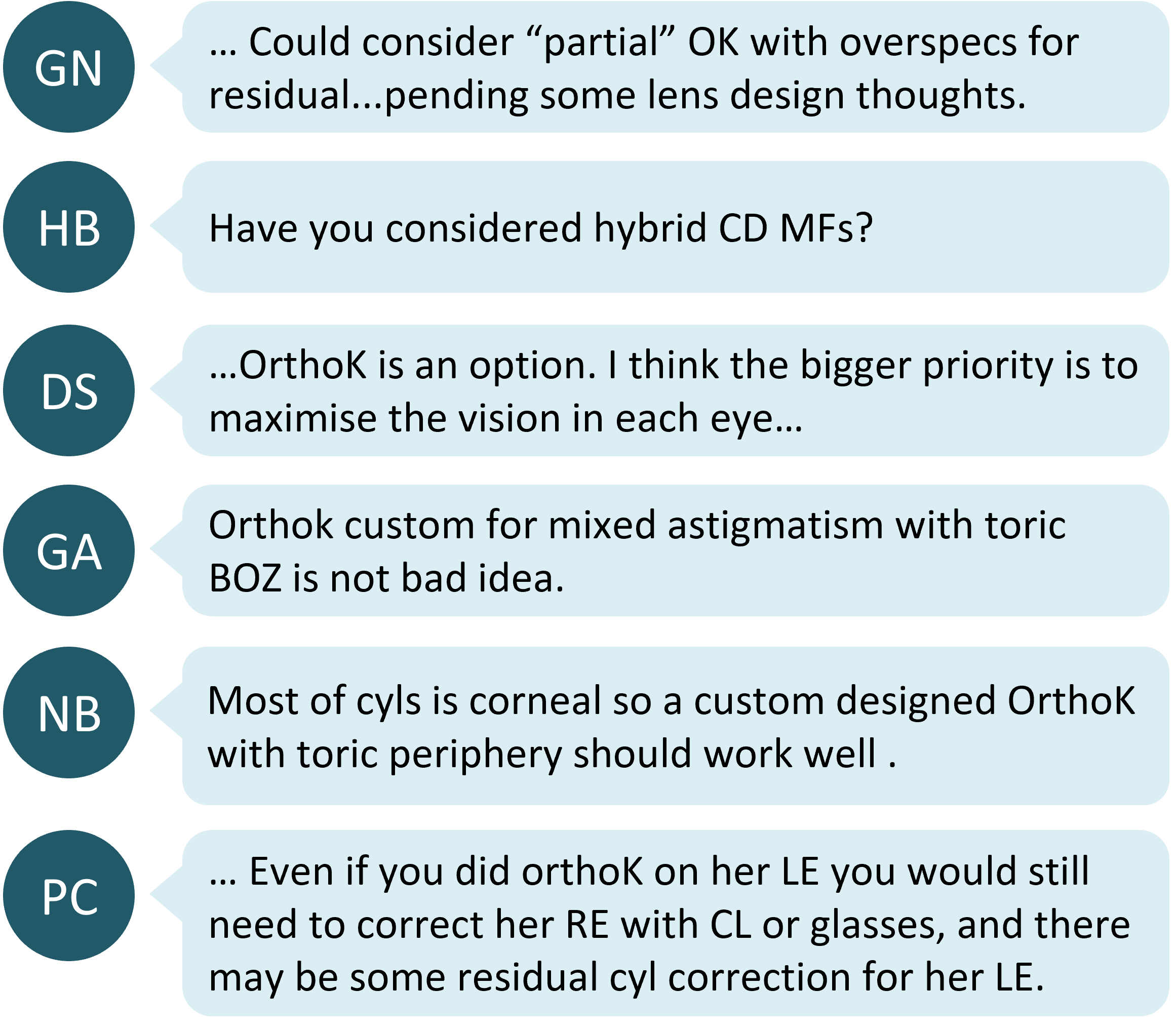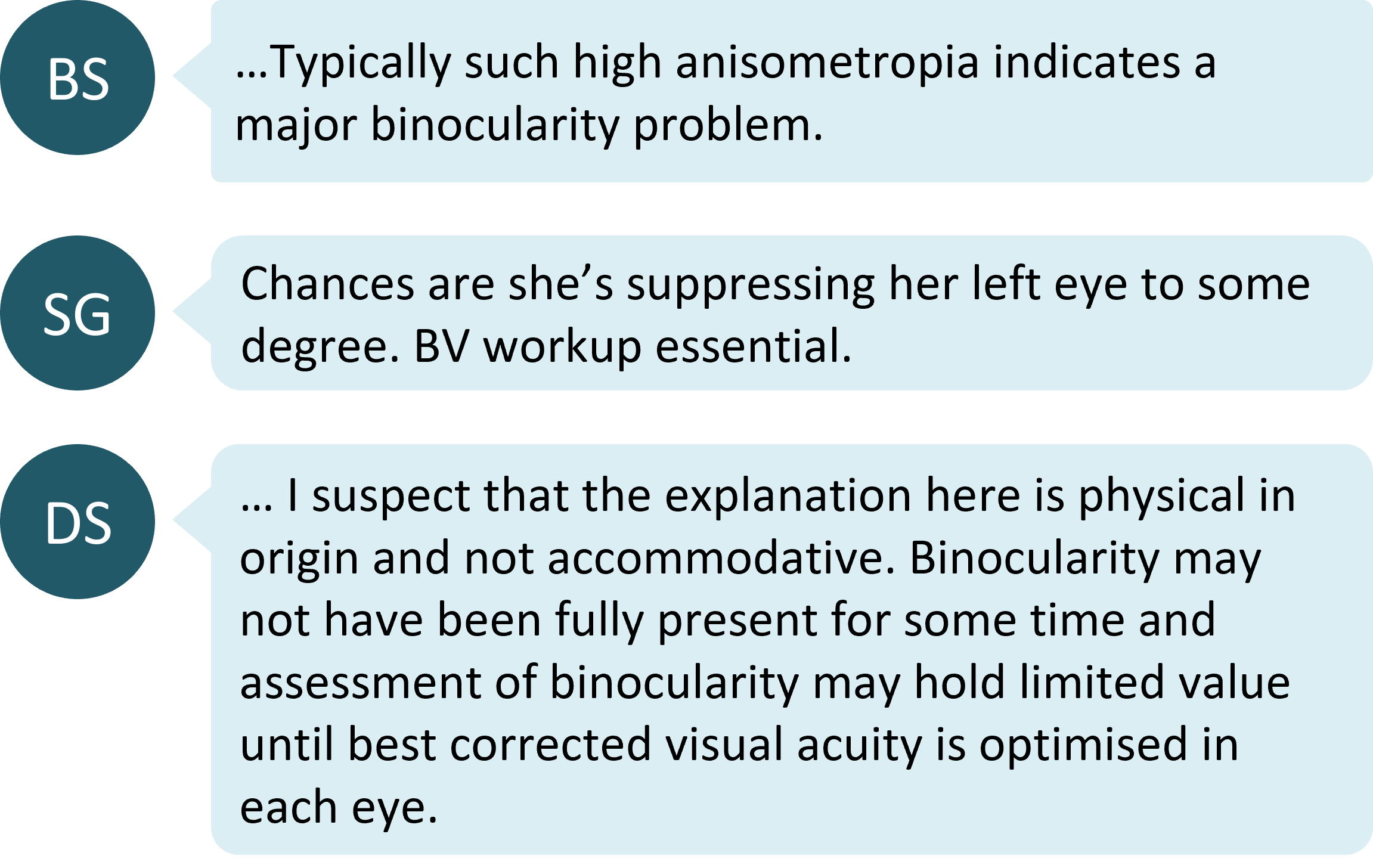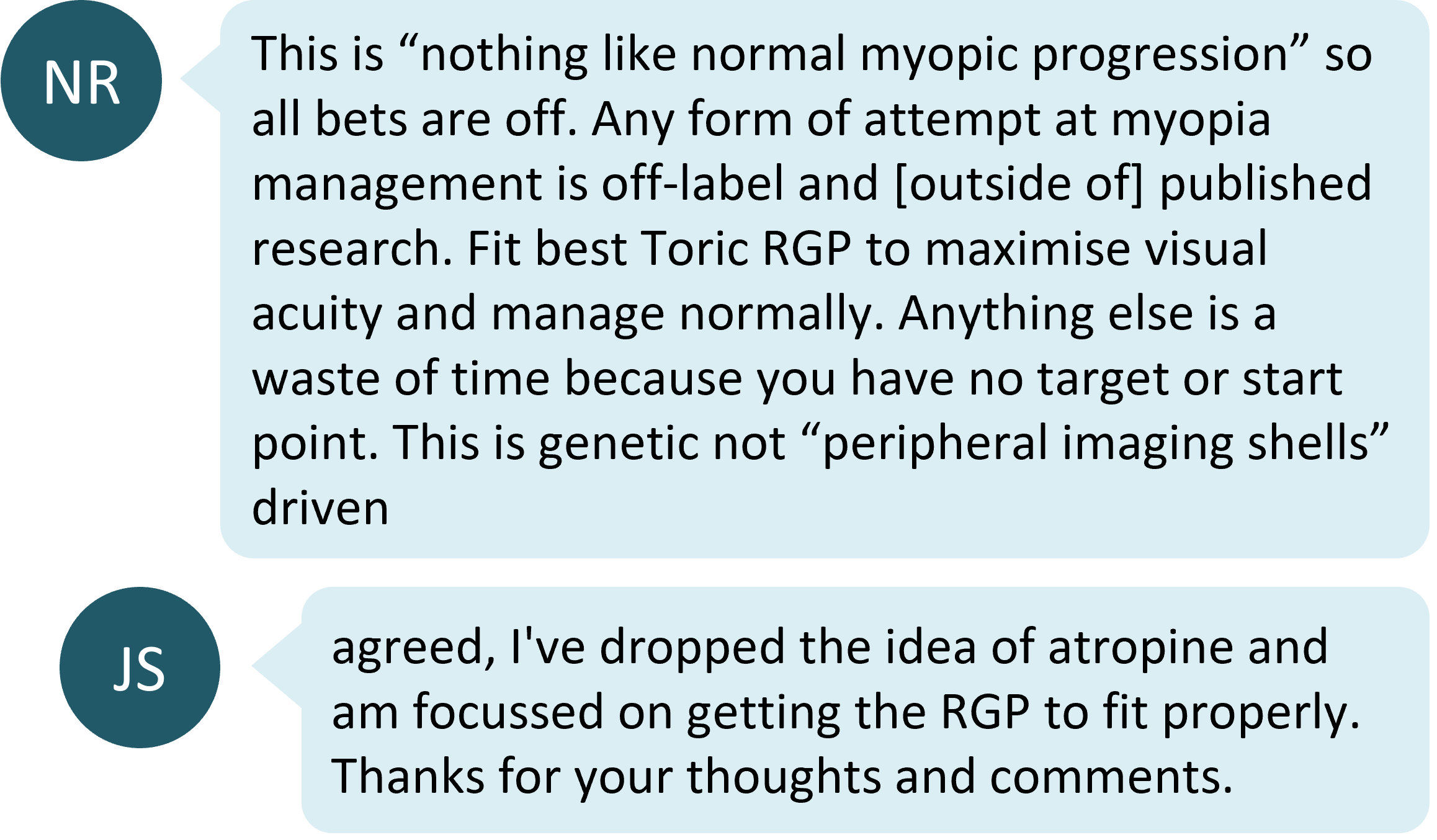Every now and then, when you think you’ve got myopia control all figured out, a tricky case like this will present. How do you manage unilateral myopia with high astigmatism? JS shared a case with the Myopia Profile Facebook community involving a teen who is hyperopic in one eye, myopic in the other, and highly astigmatic in both eyes. Here are the details.

When a patient is hyperopic in one eye and myopic in the other, this is called antimetropia. Antimetropia is rare and management can be complex. The prevalence of antimetropia in a Korean study of 1100 patients was 0.2%.1 Antimetropia can cause amblyopia - the greater the refractive error difference between the eyes, the typically poorer vision in the amblyopic eye.2 Hence, in such cases, one may find themselves with competing clinical priorities to attend to.
JS offers us his management plan:
- To firstly fit the patient with corneal RGPs in order to optimize visual acuity in the left, myopic eye
- Consider prescribing 0.02% atropine bilaterally to slow the axial elongation in the myopic eye.
- Recommend visual hygiene, frequent breaks with near work and increased outdoor time.
- Review in 3 months to check for improved VA and a binocular vision workup.
Do you agree with this plan?

Most commenters agreed with this plan of management - focusing first on improving visual acuity in the left eye with an RGP fit for high myopia and astigmatism, followed by assessing and enhancing binocular vision status, then reassessing the patient for myopia control.
Is there anything else we can add?
As there is no textbook treatment for this patient, we shall tease out the various considerations in our approach to managing monocular myopia with high astigmatism.
Other contact lens options

The most popular alternative contact lens option was orthokeratology (OrthoK) lenses with spectacles correcting residual myopia and/or astigmatism. OrthoK could be pursued to offer both myopia correction and a myopia control effect for the left eye.
Partial orthokeratology treatment has shown efficacy for myopia control: in the High Myopia-Partial Reduction Orthokeratology (HM-PRO) study, children with at least -6.00D of myopia were corrected to -4.00D with OrthoK, and their residual refractive error corrected with single vision distance spectacles. The myopia control effect was similar to that found in studies in which full refractive correction was achieved with OrthoK lenses.3
OrthoK is also the only intervention for myopia control which shows efficacy for myopia in combination with higher astigmatism. The TO-SEE study corrected children with between 1.25D and 3.50D of astigmatism with OrthoK, and found again a similar myopia control effect to that in children in other studies with lower astigmatism.4
It is worth noting two things for this case.
- The child has 4.00D of astigmatism in her left, myopic eye. Astigmatism correction to this level of astigmatism has not been studied.
- The child is 16 years old. A meta-analysis of the myopia control efficacy of orthokeratology included studies with children aged 6-16 years5 so this is evidence-based treatment based on age, but at the upper limit.
The other suggestion was to fit the child with a centre-distance multifocal hybrid lens, which involves an RGP optical centre with a soft contact lens skirt. This could be an option for vision correction, but there are no studies on use of this lens for myopia control.
Binocular vision

We should always investigate a patient’s binocular visual status when they have anisometropia or antimetropia. In anisometropes, stereoacuity can be reduced due to amblyopia and optical effects of correction.6 Stewart et al showed improved stereoacuity after amblyopia treatment.7 Therefore, the focus on improving left eye visual acuity may serve to improve the binocularity, and the improved binocularity may in turn reduce the rate of myopic progression. This assumption is based on reducing retinal blur, a driver for myopia progression,8 as there is no data on myopia progression in amblyopia.
Is there keratoconus?

Due to high levels of corneal toricity, one of the commenters was suspicious of keratoconus. However, the patient’s ophthalmologist had already ruled it out. It is still worthwhile monitoring the topography annually if there is any suspicion of corneal ectasia.
This is not a normal myopia

Most myopia control research typically does not include patients with anisometropia or amblyopia, therefore good patient communication is needed to avoid overpromising and to ensure informed consent.5
OrthoK, however, does hold the distinction of being the only intervention for which there is evidence of myopia control in anisometropia, indicating slower growth of the more myopic eye as well as slower overall growth of both eyes.9 Read more in this Myopia Profile Science Review.
Interestingly, throughout discussion of this case, the managing eye care professional JS decided to abandon the idea of prescribing atropine for myopia control in the first instance, and instead focus on achieving the best possible acuity for the left eye with high myopia and astigmatism.
A similar case study
Makino10 described a similar case of monocular myopia with astigmatism in a 10-year-old boy with a refraction of right (R/OD) -6.00/-2.00×170 and left (L/OS) +1.50/-2.00×5. Despite normal best-corrected acuity in each eye (6/6 or 20/20), the boy was found to have right esotropia and hypertropia. He also had a tilted disc and inferior staphyloma in the right eye. This illustrates the need to explore other driving factors that lead to anisometropia or antimetropia, and highlights the necessity of full anterior and posterior ocular health assessment. This child was treated with full refractive correction with prism, and good binocular vision function was reported.
Take home messages:
- Ensure a full evaluation of ocular health for any abnormalities that may be a cause of anisometropia and especially amblyopia.
- The priority in these atypical myopia cases is to firstly optimize vision and binocularity - in this case, the high ametropia led to prescribing of a corneal RGP lens. Myopia control can often be a lesser priority in these cases, although some optical treatments for myopia can offer the benefit of both correcting myopia and providing a potential for slowing myopia progression.
- Be diligent in communicating the expectations for any myopia control strategies which are not studied or off-label, as might occur in these atypical cases.

About Kimberley
Kimberley Ngu is a clinical optometrist from Perth, Australia, with experience in patient education programs, having practiced in both Australia and Singapore.

About Connie
Connie Gan is a clinical optometrist from Kedah, Malaysia, who provides comprehensive vision care for children and runs the myopia management service in her clinical practice.
This content is brought to you thanks to an unrestricted educational grant from
![]()
References
- Yu DS. The Dioptric Differences between Both Eyes by Dioptric Power Matrix. Journal of Korean Ophthalmic Optics Society. 2003;8(2):71-6. (link)
- Buqu Z, Hengjian S. Analyzing ametropia of children with antimetropia amblyopia. Hebei Medicine. 2003 Jan 1;9(10):900-2. (link)
- Charm J, Cho P. High myopia-partial reduction orthokeratology (HM-PRO): study design. Cont Lens Anterior Eye. 2013 Aug;36(4):164-70. (link)
- Chen C, Cheung SW, Cho P. Myopia control using toric orthokeratology (TO-SEE study). Invest Ophthalmol Vis Sci. 2013 Oct 3;54(10):6510-7. (link)
Ateiza, A. and Davis, H., 2019. The Effects of Anisometropic Amblyopia on the FNS and TNO Stereotest Thresholds in Four- to Eight-Year-Olds. British and Irish Orthoptic Journal, 15(1), 72–81. (link) - Sun Y, Xu F, Zhang T, Liu M, Wang D, Chen Y, Liu Q. Orthokeratology to control myopia progression: a meta-analysis. PLoS One. 2015 Apr 9;10(4):e0124535. (link)
- Vincent SJ, Collins MJ, Read SA, Carney LG. Myopic anisometropia: ocular characteristics and aetiological considerations. Clinical and Experimental Optometry. 2014 Jul;97(4):291-307. (link)
- Stewart CE, Wallace MP, Stephens DA, Fielder AR, Moseley MJ, Cooperative MO. The effect of amblyopia treatment on stereoacuity. Journal of American Association for Pediatric Ophthalmology and Strabismus. 2013 Apr 1;17(2):166-73. (link)
- Troilo D, Smith EL 3rd, Nickla DL, Ashby R, Tkatchenko AV, Ostrin LA, Gawne TJ, Pardue MT, Summers JA, Kee CS, Schroedl F, Wahl S, Jones L. IMI - Report on Experimental Models of Emmetropization and Myopia. Invest Ophthalmol Vis Sci. 2019 Feb 28;60(3):M31-M88. (link)
- Tsai HR, Wang JH, Chiu CJ. Effect of orthokeratology on anisometropia control: A meta-analysis. J Formos Med Assoc. 2021 Dec;120(12):2120-2127. (link)
- Makino S. Antimetropia in a 10-year-old boy with unilateral tilted disc syndrome. Clinical Optometry 2014;6:43-45. (link)











